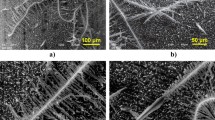The influence of the polarization conditions on growth dynamics and structure of electrolytic zinc dendritic deposits obtained at room temperature from electrolyte with 0.3 mol/l zinc oxide and 4 mol/l sodium hydroxide is studied. The electrodeposition was performed at constant and pulsed current and potential. Constant-current chronopotentiometry was used to determine the surface area of the dendritic deposits in situ. The zinc microstructure was studied with electron microscopy. The deposit surface produced in pulsed current conditions intensively grew during the first 5 minutes of electrolysis and then changed insignificantly. In conditions of potentiostatic electrolysis, the coefficient K, which is the ratio of the deposit surface area to the substrate area, increased linearly with time; in pulsed potential conditions, it increased as a power-law functions. The deposits obtained in potentiostatic conditions show the lowest density that slightly varies with thickness. The density of the deposits crystallized in pulsed current conditions sharply increased upon the completion of active dendrite extension.






Similar content being viewed by others
References
B. Murashova and A. B. Pomossov, “Electrodeposition of metal dendrites,” in: Advances in Science. Ser. Electrochemistry [in Russian], Issue 30, VINITI, Moscow (1989), pp. 55–145.
K. I. Popov, M. Maksimonic, D. Lucic, and M. G. Pavlonic, “The mechanism of copper powder formation in potentiostatic deposition,” J. Appl. Electrochem., No. 10, 239–246 (1980).
N. D. Nicolic, K. I. Popov, Lj. J. Pavlonic, and M. G. Pavlonic, “Morphology of copper electrodeposits, obtained by electrodeposition at high overpotentials,” Surf. & Coat. Techn., 201, 560–566 (2006).
B. Murashova, S. L. Korkin, and I. N. Yankelevich, “The dynamics of growth of disperse deposit during galvanodynamic electrolysis,” in: Advances in Science. Ser. Electrochemistry [in Russian], Issue 22, VINITI, Moscow (1986), pp. 1243–1246.
N. D. Nikolic, K. I. Popov, Lj. J. Pavlovic, and M. G. Pavlovic, “New method of the determination of specific surface of copper obtained by the electrodeposition,” Zaštitah Materijala’, 48, No. 1, 3–8 (2007).
U. D. Trenyakov, “Dendrites, fractals, and materials,” Soros. Obrazovat. Zh., No. 11, 96–102 (1998).
B. N. Smirnov, The Physics of Fractal Clusters [in Russian], Nauka, Moscow (1991), p. 136.
Ullah Shafiq, Badshahl Amin, Ahmed Fiaz, et al., “Electrodeposited zinc electrodes for high current Zn/AgO bipolar batteries,” Int. J. Electrochem. Sci., 6, 3801–3811 (2011).
D. U. Turayev, “Studying the application of new AM567 additive for alkaline electrolytic galvanizing,” in: Proc. 8th Int. Exhib. Conf. on Surface Treatment and Coating [in Russian], Ross. Khimiko-Tekhnol. Univ. im. D. I. Mendeleeva, Moscow (2011), pp. 80–82.
O. Chertaeva, T. N. Ostanina, B. M. Rudoi, and V. S. Nikitin, “In situ determination of the surface area of zinc dendritic deposits,” in: Proc. 6th All-Russia Conf. “Mendeleev-2012” [in Russian], Solo, Saint-Petersburg (2012), pp. 122–124.
Z. Galus, Fundamentals of Electrochemical Analysis, Ellis Harwood, Chichester (1976).
B. Darintseva, A. V. Patrushev, T. N. Ostanina, and V. B. Malkov, “Electrocrystalization of dendritic zinc and nickel deposits in galvanostatic conditions,” Vestn. Kazan. Tekhnol. Univ., 15, No. 19, 62–66 (2012).
Acknowledgements
The authors are grateful to Prof. I. B. Murashova for discussions and valuable remarks during the tests and preparation of the article.
The study was supported by the Russian Foundation for Basic Research (Grant No. 11-03-00226).
Author information
Authors and Affiliations
Corresponding author
Additional information
Translated from Poroshkovaya Metallurgiya, Vol. 52, No. 9–10 (493), pp. 3–14, 2013.
Rights and permissions
About this article
Cite this article
Ostanina, T.N., Rudoi, V.M., Darintseva, A.B. et al. Effect of the Polarization Conditions on the Structural Properties of Zinc Dendritic Deposits. Powder Metall Met Ceram 52, 489–497 (2014). https://doi.org/10.1007/s11106-014-9551-0
Received:
Published:
Issue Date:
DOI: https://doi.org/10.1007/s11106-014-9551-0




